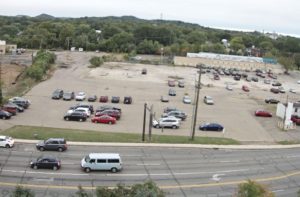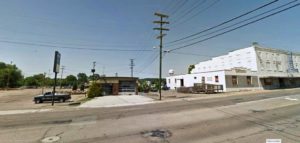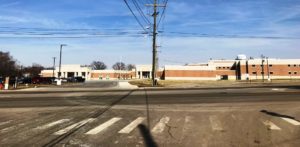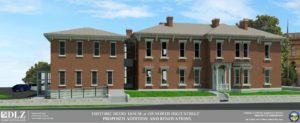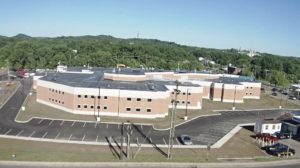A Guest Article for REVITALIZATION by Carri L. Brown.
Note from Storm Cunningham: Too often, local, state and federal government agencies build new facilities without any thought for how the project might affect downtown revitalization efforts. Witness all the post offices that the U.S. Postal Service (not actually a government agency, granted) helped kill hundreds of downtowns over the past few decades by moving post offices from downtown locations to the suburbs. When Fairfield County, Ohio needed a new jail, they were determined to fulfill that goal in a way that supported—rather than undermined—their downtown revitalization efforts. In the process, they reused an existing site and improved public safety. Here’s how they did it:
Planning a major project to build a jail and public safety facility comes with challenges. Those challenges, though, do not prevent the integration of downtown revitalization into overall strategies for a community. Experienced public administrators might think attempting such integration might be a recipe for disaster, but it can be done. Here is an example from Fairfield County, Ohio, where a downtown site was redeveloped to improve public safety services and support downtown revitalization.
Building a New Jail and Public Safety Facility Sparked Controversy
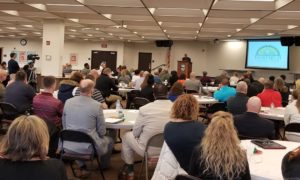 From 1999 to 2013, there were lively debates in Fairfield County, Ohio, about building a new public safety facility and jail. The decision to move forward was a complex one, and there was no progress on the project for 14 years.
From 1999 to 2013, there were lively debates in Fairfield County, Ohio, about building a new public safety facility and jail. The decision to move forward was a complex one, and there was no progress on the project for 14 years.
Part of the complexity of the project was that there lacked consensus on the new location of the facility. The image of what a new jail would look like was grounded in the past, with razor wire fences and foreboding appearances. People simply were not very eager for this type of facility near their homes or businesses.
There was consensus, however, on the need for an upgraded facility based on ongoing reports from the County Sheriff, law enforcement professionals, and other stakeholders. The overarching problem was that operations of three jails and a detective bureau were unsustainable in the long run. Further, failed state inspections of the jails added to the pressure to change. The decision to build a new jail was important for public safety. It was also important to revitalization of the community.
Two of the three old jail locations were in downtown (or downtown adjacent) sites of Lancaster, the county seat. These two locations were sorely overcrowded, outdated, and dilapidated. The detective bureau was also located in downtown Lancaster, while the third jail was located miles away in a leased, state facility.
For the new construction, Fairfield County owned two suitable sites. One was in a downtown area, while the other was not. After thoughtful consideration, county leaders decided to construct a $35 Million, 384-bed facility in the downtown area, repurposing an existing jail site. Adapting the existing site, though, was not without problems, including environmental concerns.
The Reuse of the Existing Site Came with Unique Challenges
Conflicts arose throughout the site reuse process. Some stakeholders were concerned about the reuse of the existing site, claiming the project could endanger the water supply from the aquifer below the construction site.
Environmental stewardship is an important goal of Fairfield County, and there was significant investment made to ensure City regulations were met and to ensure confidence in the safety of the project.
For example, environmental consultants, Bennett and Williams, were brought into the project during the early phases of construction because of the unique challenges presented at the site. In the early 1900s, the site was used in part to dispose of foundry sand generated by a nearby foundry, Alten’s Foundry. The site had poor soil compaction and a potential for waste to be carried into the aquifer.
Fairfield County was dedicated to ensuring that the City’s wellfield would not be impacted and proposed voluntary measures designed to minimize any impact to the aquifer both during and after construction. These measures included “casing off” the fill materials as part of the construction of the auger cast piles, minimizing the downward transport of fill materials into the aquifer.
Fairfield County took extensive precautions during the investigation, preparation, and construction phases of the project. In the end, analyses demonstrated there was no increased risk to the wellfield, as some people had feared. Rather, the measures decreased the inconsequential risk posed and improved the impact to the environment. Results of a leaching model showed (under both pre-construction and post-construction conditions) none of the hazardous constituents present in on-site fill will leach to groundwater in 100 years, the standard period used in leaching assessments.
In fact, the model—which used the most conservative input parameters—showed the construction elements would result in slower leaching of constituents than what was expected previously. Linda Aller, Principal Geologist with Bennett and Williams, stated, “The work of the construction project decreased the minimal risk the site posed to the wellfield, improving wellfield protection and access to safe drinking water.” The innovative use of “cased-off” auger cast pilings for the foundation added costs to the project but allowed for environmental stewardship within the reuse process.
The Aim of the Reuse Process Was to Improve Services While Promoting Revitalization
The existing site in the downtown area was chosen to improve public services. The proximity to the downtown courthouses was important to stakeholders, such as the judiciary, County Sheriff, County Prosecutor, law enforcement professionals, and the legal community.
They favored a location close to the courts to improve transportation, safety, and efficiency. In addition, making use of the existing downtown location provided an opportunity for downtown revitalization.
Dennis Keller, Fairfield County Facilities Manager, stated, “We took action to improve a desolate, blighted city block. We began with building foundation remnants and an old concrete parking lot from former department stores; we ended with a modern, attractive professional building. It is highly functional and improves services while promoting revitalization.” There were few, if any, other options available for redevelopment at the selected site. Improving the site could help support the local economy, and this aspect required the government to pay attention to details promoting the visual appeal of the facility.
In 2014, architects for the building, Wachtel & McAnally, were charged with creating a facility that coordinated well with the look of the historic downtown area. The building was designed with the appearance of an office building or government administrative building. The facility utilized the latest technology for staffing efficiencies, and the secure perimeter was contained within the building. This meant there was no fence (razor wire or other type) surrounding the building.
Gary McAnally, Principal Architect, stated, “We dedicated ourselves to making sure the building looked like a commercial building, as opposed to a correctional facility. We used materials you would expect to see in commercial buildings, and the design complemented the look of buildings in the neighborhood. The stepped elevation of the building, the placement of the jail portion, and the exterior design all contributed to the commercial look of the building.”
The construction management firm, Granger, Inc., joined the project in August of 2015, once complete financing for the new building had been secured. Granger coordinated with county staff and initiated weekly project management meetings to clarify and identify goals and objectives, keeping the project on time and on budget. A stated goal was to ensure the building was integrated with the City of Lancaster and the downtown area. The collaboration with the public officials, architect, and construction manager worked well to further this goal.
In August of 2017, the construction was completed. Previous overcrowded, inefficient conditions were replaced with a new jail and public safety facility consisting of 384 beds, administrative offices, a 9-1-1 dispatch center, and training areas. The building now includes housing, intake services, visitation spaces, classrooms, outdoor recreation areas, a full-service kitchen, sallyport, and other support spaces. The facility is 110,000 square feet, combining Sheriff’s operations into one location from the previous four locations. The project provided efficiency for the public and repurposed property to improve the economic outlook.
Local businessman Jeff Jones, of Jones and Company, LLC, stated, “The commercial look of the new jail blends in well with the downtown. It was a dramatic improvement for the community. After the construction was completed, it was interesting in how a new jail contributed to a positive economic outlook.” The new jail and public safety facility improved the visual appeal of the downtown area.
The Project Contributed to Additional Downtown Revitalization
Along with the opening of the new jail and public safety facility, the community experienced encouraging growth and development. Certainly, the improvements of the facility and economic development should not be thought of as a cause and effect relationship.
However, the new facility, with its attractive façade and improvements it afforded the area, is a factor in how people viewed the future of the downtown. The community is working on its ability to attract and retain people and businesses, while nurturing an appealing look of the city.
Less than a block away from the new public safety facility and jail, there is the much-anticipated development of an historic hotel, the Mithoff, which is nearly 200 years old. A local businessman is investing $3 – $4 million in the redevelopment of the Mithoff. In Spring of 2018, there will be new retail spaces in the lower area of the Mithoff, with a wine shop and wine tasting room.
In addition, in the downtown (or near downtown) area, there will be a new pub, restaurant, movie production studio, micro-brewery, and event space opening within the year. The private sector is experiencing growth, and the public sector, too, is continuing its efforts to support downtown revitalization.
The historic building that formerly housed the detective bureau (now located in the new jail and public safety facility) will be the new location of the County Auditor’s Real Estate Assessment Offices. County leadership has pledged to maintain the historic significance of the building, which was originally constructed in the 1830s.
Early renderings of the $2 million project are available. Construction is expected to begin in late 2018. Historical preservation of the building is integral to planning in the area because it furthers economic vitality and environmental stewardship. The preservation will acknowledge and sustain a community and cultural asset.
Further, a new records center is planned a block away from Main Street. That property includes a 16,320-square foot office building, which will be used for office space relating to the records center. Initially, the new records center will house records from the County Clerk of Courts. Over time, all county departments will be able to use the records center. The centralized location will allow easier public access to stored records for multiple departments and agencies.
The target date for the opening of the records center is 2019. Branden Meyer, Clerk of Courts, stated, “The new records center on Chestnut Street will include modern conference space that we intend to use for training, which will bring more people downtown.” Fairfield County is adapting additional buildings while keeping downtown revitalization efforts in mind.
The Reuse of Buildings Is Part of the Story – How Lives Are Affected is Most Important
With the construction of the jail and public safety facility, the reuse of an existing site and the potential of downtown revitalization was one part of the story. However, the way redevelopment would allow for better services for people in Fairfield County was most important.
Prior overcrowded conditions, which often presented behavior issues at the jail, have been addressed. Medical services for those incarcerated have improved with contracted, trained medical service providers who have better medical facilities at the jail. As the reuse process unfolded, there was ongoing consideration for how lives could be improved – for people engaged in the criminal justice systems and for all members of society.
During the design phases of construction, consideration was given to social services that could be provided at the jail. One improvement was the inclusion of conference space for programming. There is now an ability to hold additional counseling sessions and training sessions. Volunteers from faith-based and community groups provide counseling services for inmates, and additional options are under review for the provision of mental health services.
Further, video visitation services, held through kiosks at the cells, are now available for the public. Previously, visitation with families and friends was often unavailable because old, outdated visitation equipment needed repair, and it was difficult to obtain replacement parts. The new system allows for safe visits, and video visitation services have been met with positive feedback from the public. The process has a potential to expand inmates’ access to visits from families and friends.
In addition, the Sheriff’s Office now includes a Reentry Coalition with a Reentry Coordinator reporting to the Jail Commander. With the Reentry Coalition under the leadership of the Sheriff’s Office, there is greater opportunity for inmates to access community services as they prepare for release from incarceration. The Reentry Coalition convenes local service providers and reentry specialists, reaching more than 70 stakeholders on a regular basis. With the Reentry Coalition, there is a community roundtable to broadcast available resources. Informational sessions improve coordination and awareness between the participating organizations, including the parole authority, social service providers, faith-based groups, reentrants, and others.
Providing reentry related services prior to release is a major benefit of the program. For example, while employment is a key goal, many reentrants need other services before they can succeed in a job. The Reentry Coordinator at the jail conducts risk assessments and directly provides case management by developing connections to mental health services, alcohol and drug abuse counseling, housing referrals, and pre-release training. Community partners are now working together to begin a database to track outcomes. Improved services for the public, whether engaged in the criminal justice system or not, are made possible with the new facility.
About The Author:
 Carri L. Brown is the County Administrator for Fairfield County, Ohio. As County Administrator, Carri recommends and implements policy of the Board of County Commissioners. She supervises department heads and provides executive level leadership to other elected officials, statewide associations, and local agencies to engage governments, non-profits, faith-based groups, and businesses to achieve a common mission of community improvement.
Carri L. Brown is the County Administrator for Fairfield County, Ohio. As County Administrator, Carri recommends and implements policy of the Board of County Commissioners. She supervises department heads and provides executive level leadership to other elected officials, statewide associations, and local agencies to engage governments, non-profits, faith-based groups, and businesses to achieve a common mission of community improvement.
Carri is a Certified Government Financial Manager and a member of several professional organizations including the Government Finance Officers’ Association, the Association of Government Accountants, and the International Association of County and City Managers. She graduated summa cum laude from Ohio University with a Bachelor of Business Administration and a Master of Business Administration from Ohio University. She is a doctoral candidate with an expected graduation date of 2018. Carri can be reached at carri.brown@fairfieldcountyohio.gov


